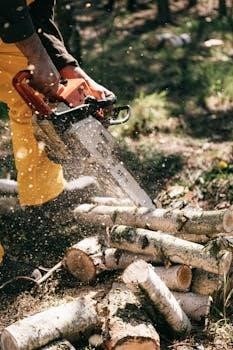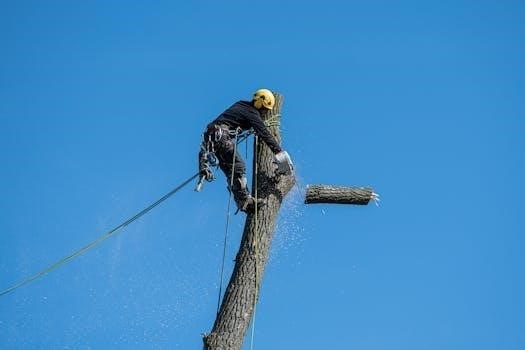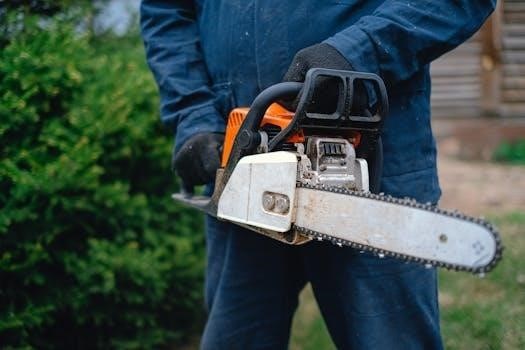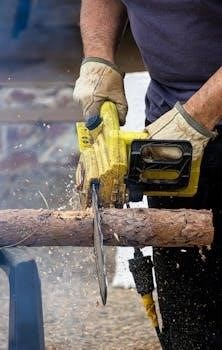
echo cs 310 chainsaw manual
Echo CS-310 Chainsaw Manual⁚ A Comprehensive Guide

This comprehensive guide serves as your essential resource for the Echo CS-310 chainsaw, offering detailed instructions and safety protocols․ The manual will help you understand the tool’s operation and maintenance, and ensure optimal performance and longevity․
The Echo CS-310 is a versatile chainsaw designed for both professional and home use, boasting a compact and lightweight construction for easy handling and maneuverability․ It is a reliable tool for various cutting tasks, from pruning and limbing to felling small trees․
This chainsaw incorporates features that enhance user experience, including a powerful engine for efficient cutting and an anti-vibration system for reduced fatigue during extended use․ The CS-310 also prioritizes safety with features like a chain brake and throttle interlock․
This manual provides comprehensive information on the safe operation, maintenance, and troubleshooting of the Echo CS-310 chainsaw․ Understanding the content will enable you to use the chainsaw effectively and safely, ensuring its long-term performance․ Always consult this guide before operating the chainsaw and adhere to all safety precautions․ Remember that regular maintenance is crucial for keeping your CS-310 in top condition․ Genuine Echo parts are recommended for all repairs and replacements․
Safety Precautions and Warnings
Operating a chainsaw involves inherent risks, making strict adherence to safety precautions paramount․ Before using the Echo CS-310, thoroughly read and understand all safety warnings and instructions outlined in this manual and the accompanying safety manual․ Failure to do so could result in severe personal injury․
Always wear appropriate personal protective equipment (PPE), including eye protection, hearing protection, head protection, gloves, and sturdy footwear․ Avoid loose clothing or jewelry that could get caught in the chainsaw․ Maintain a firm grip on the chainsaw with both hands and ensure a stable footing․ Never operate the chainsaw while under the influence of drugs or alcohol, or when fatigued․ Be aware of the risk of kickback, a sudden and forceful backward motion of the chainsaw, which can cause serious injury․ Avoid cutting with the tip of the guide bar, which is the most common cause of kickback․ Keep bystanders and animals away from the work area․
Inspect the chainsaw before each use, checking for any damage or loose parts․ Ensure that the chain is properly tensioned and sharpened․ Never operate the chainsaw with a damaged or malfunctioning muffler․
Operating Instructions
Before commencing any cutting operation with your Echo CS-310 chainsaw, ensure that you have thoroughly reviewed and understood the safety precautions․ Begin by inspecting the work area for any obstructions or hazards․ Clear away any debris or obstacles that could interfere with your movement or the chainsaw’s operation․
Always maintain a firm and balanced stance, keeping both feet firmly planted on the ground․ Grip the chainsaw firmly with both hands, ensuring that your thumbs are wrapped around the handles․ Start the chainsaw according to the instructions outlined in the fueling and starting section of this manual․ Once the chainsaw is running smoothly, position the chain against the wood to be cut․ Apply gentle pressure and allow the chain to do the work, avoiding forcing the chainsaw through the wood․
When cutting, maintain a safe distance from your body and avoid overreaching․ Be mindful of the direction of the falling tree or branch, and ensure that there are no people or objects in the path of the falling material․ If the chainsaw becomes pinched or stuck, stop the engine and carefully remove the chainsaw from the cut․
Fueling and Starting the Chainsaw
To ensure the safe and efficient operation of your Echo CS-310 chainsaw, proper fueling and starting procedures are crucial․ Begin by preparing the correct fuel mixture, which is typically a blend of gasoline and two-stroke oil․ Consult your owner’s manual for the specific ratio recommended by Echo for your model, but it is typically a 50⁚1 ratio․ Use fresh, high-quality gasoline with an octane rating of 89 or higher․
Before fueling, ensure the chainsaw is placed on a flat, stable surface away from any potential ignition sources․ Carefully remove the fuel cap and pour the fuel mixture into the tank, avoiding spills․ Replace the fuel cap securely․
To start the chainsaw, engage the chain brake․ Then, locate the choke lever and set it to the “cold start” position․ Next, firmly grasp the starter handle and pull it repeatedly until the engine sputters․ Once the engine sputters, move the choke lever to the “run” position․ Continue pulling the starter handle until the engine starts and runs smoothly․ Allow the chainsaw to idle for a few minutes to warm up before engaging the chain brake and beginning cutting operations․ If the engine fails to start after several attempts, consult the troubleshooting section of this manual․
Chain and Guide Bar Information
Understanding the specifications of your Echo CS-310 chainsaw’s chain and guide bar is essential for safe and efficient operation․ The guide bar serves as the track along which the chain rotates, and its length determines the maximum cutting diameter․ Echo recommends specific guide bar lengths for the CS-310 model, which are typically 12, 14, or 16 inches․ Using an incorrect guide bar length can compromise the chainsaw’s performance and safety;
The chain itself is composed of several components, including cutters, tie straps, and drive links․ The chain’s pitch, gauge, and type must match the specifications recommended for the CS-310․ The pitch refers to the distance between the chain’s rivets, while the gauge refers to the thickness of the drive links․
Low-kickback chains are recommended for novice users to reduce the risk of kickback, a dangerous phenomenon where the chainsaw suddenly thrusts backward․ Regular inspection and maintenance of the chain and guide bar are crucial․ Sharpen the chain regularly to maintain its cutting efficiency, and inspect the guide bar for wear and damage․ Replace the chain or guide bar if they are excessively worn or damaged․ Always consult the owner’s manual for the correct chain and guide bar specifications and maintenance procedures․

Chain Tensioning and Adjustment
Proper chain tension is crucial for the safe and efficient operation of your Echo CS-310 chainsaw․ A chain that is too loose can derail from the guide bar, while a chain that is too tight can cause excessive wear and tear on the bar, chain, and engine․ Always check and adjust the chain tension before each use, and periodically during operation․
To adjust the chain tension, first, loosen the bar nuts that secure the guide bar to the chainsaw․ Then, locate the chain tensioning screw, typically located on the side of the chainsaw near the guide bar․ Use a screwdriver to turn the tensioning screw, adjusting the chain until it fits snugly against the guide bar․ The chain should be able to be pulled around the bar by hand, but should not sag excessively․
Once the chain is properly tensioned, tighten the bar nuts securely․ It is important to note that new chains will stretch during the first few uses, so it may be necessary to readjust the tension frequently during this period․ Always refer to your Echo CS-310 chainsaw’s manual for specific instructions and diagrams related to chain tensioning and adjustment․ Regular checks and adjustments will ensure optimal performance and extend the life of your chainsaw․

Maintenance and Servicing
Regular maintenance and servicing are paramount for ensuring the longevity and optimal performance of your Echo CS-310 chainsaw․ Neglecting these essential tasks can lead to decreased efficiency, potential safety hazards, and costly repairs down the line․ A well-maintained chainsaw is a safer and more reliable tool․
Begin by consistently cleaning the air filter to prevent engine strain․ Regularly inspect and clean the spark plug to ensure proper ignition․ Keep the chain properly sharpened for efficient cutting and reduced kickback risk; Periodically check the fuel lines and filter for any signs of damage or clogging․ Examine the guide bar for wear and tear, ensuring it is properly lubricated․
For more extensive servicing, such as carburetor adjustments or internal engine repairs, it’s recommended to consult a qualified technician or refer to the Echo CS-310 service manual․ Always use genuine Echo parts for replacements to maintain the chainsaw’s original specifications and warranty․ Following a consistent maintenance schedule will not only prolong the life of your Echo CS-310 but also ensure it operates safely and efficiently for years to come․ Always disconnect the spark plug before performing any maintenance․
Troubleshooting Common Issues
Even with proper maintenance, the Echo CS-310 chainsaw may encounter occasional issues․ Troubleshooting these problems effectively can save time and money on repairs․ One common issue is difficulty starting the engine․ This could be due to a fouled spark plug, stale fuel, or a clogged air filter․ Ensure the spark plug is clean and properly gapped, use fresh fuel mixed to the correct ratio, and clean or replace the air filter․
Another common problem is the chain not receiving adequate lubrication․ Check the oil reservoir level and ensure the oiler is functioning correctly․ A clogged oiler can be cleared with compressed air or a small wire․ If the chain is cutting poorly, it may need sharpening or replacement․ Dull chains increase the risk of kickback and put extra strain on the engine․
Overheating can also be a concern․ Make sure the air intake is clear of debris and the engine is properly ventilated․ If the chainsaw bogs down during cutting, it could indicate a carburetor issue․ Consult the service manual for adjustment procedures or seek professional assistance․ By addressing these common issues promptly, you can maintain the performance and extend the lifespan of your Echo CS-310 chainsaw․

Parts Identification and Ordering
Understanding the various components of your Echo CS-310 chainsaw is crucial for effective maintenance and repairs․ The parts manual provides detailed diagrams and part numbers for every component, from the engine to the chain and guide bar․ Familiarize yourself with this manual to accurately identify the parts you need․
When ordering replacement parts, always use genuine Echo parts to ensure compatibility and optimal performance․ Genuine Echo parts are available through authorized Echo dealers․ Using aftermarket parts may void your warranty and could potentially damage the chainsaw․ Locate your nearest authorized dealer through the Echo website or by contacting customer service․
Before ordering, double-check the part number to avoid errors․ Provide the dealer with the model number and serial number of your chainsaw to ensure you receive the correct parts․ Common replacement parts include air filters, spark plugs, fuel lines, chains, and guide bars․ Keep a record of your chainsaw’s service history and any parts that have been replaced to help with future maintenance and repairs․ The parts manual is an invaluable tool for keeping your Echo CS-310 chainsaw in top condition, facilitating easy identification and ordering of necessary components for upkeep․
Spark Arrestor Muffler Information
The Echo CS-310 chainsaw is equipped with a spark arrestor muffler, a crucial safety feature designed to prevent the emission of flammable particles from the engine’s exhaust․ This feature is particularly important when operating the chainsaw in areas with dry vegetation or where there is a risk of fire․ The spark arrestor screen traps hot particles, preventing them from igniting surrounding materials․
Regular maintenance of the spark arrestor muffler is essential for its proper function․ Over time, carbon deposits can accumulate on the screen, reducing its effectiveness and potentially causing the engine to overheat․ To clean the spark arrestor, carefully remove it from the muffler, typically by unscrewing a retaining screw or clip․ Use a wire brush to gently remove any carbon buildup․ Avoid using harsh chemicals or solvents, as they can damage the screen․
Inspect the spark arrestor screen for any damage, such as holes or tears․ If the screen is damaged, replace it immediately․ Ensure the spark arrestor is securely reinstalled after cleaning or replacement․ Operating the chainsaw with a damaged or missing spark arrestor is a fire hazard and may also violate local regulations․ Always refer to the chainsaw’s manual for specific instructions on spark arrestor maintenance and replacement to maintain safety and optimal performance․
Storage Instructions
Proper storage of your Echo CS-310 chainsaw is essential for maintaining its condition and ensuring reliable performance for future use․ Before storing the chainsaw, allow the engine to cool completely․ Drain all fuel from the fuel tank and carburetor to prevent gumming and corrosion․ This can be achieved by running the chainsaw until it stalls․ Remove the spark plug and pour a small amount of engine oil into the cylinder, then pull the starter cord several times to coat the cylinder walls․ Reinstall the spark plug․
Clean the chainsaw thoroughly, removing any sawdust, dirt, or debris from the engine, chain, and guide bar․ Inspect the chain and guide bar for damage and apply a light coat of oil to prevent rust․ Store the chainsaw in a dry, well-ventilated area away from direct sunlight and extreme temperatures․ Keep it out of reach of children and unauthorized users․
Use a guide bar scabbard to protect the chain and prevent accidental cuts․ Consider storing the chainsaw in its original case or a designated storage container․ When storing for extended periods, it is advisable to remove the battery (if applicable) and store it separately in a cool, dry place․ Following these storage instructions will help prolong the life of your Echo CS-310 chainsaw and ensure it is ready for use when needed․
Related posts:
Archives
Calendar
| M | T | W | T | F | S | S |
|---|---|---|---|---|---|---|
| 1 | 2 | 3 | 4 | 5 | 6 | 7 |
| 8 | 9 | 10 | 11 | 12 | 13 | 14 |
| 15 | 16 | 17 | 18 | 19 | 20 | 21 |
| 22 | 23 | 24 | 25 | 26 | 27 | 28 |
| 29 | 30 | 31 | ||||
Leave a Reply
You must be logged in to post a comment.